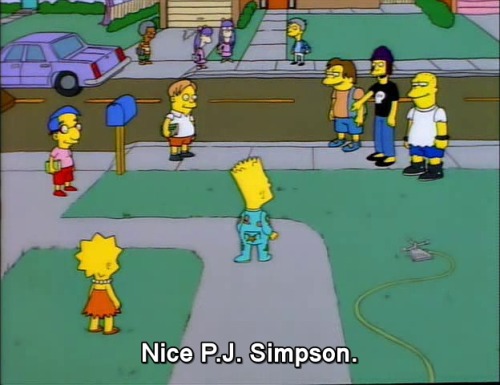Smparticle2 - Untitled






More Posts from Smparticle2 and Others

“I first ran for Congress in 1999, and I got beat. I just got whooped. I had been in the state legislature for a long time, I was in the minority party, I wasn’t getting a lot done, and I was away from my family and putting a lot of strain on Michelle. Then for me to run and lose that bad, I was thinking maybe this isn’t what I was cut out to do. I was forty years old, and I’d invested a lot of time and effort into something that didn’t seem to be working. But the thing that got me through that moment, and any other time that I’ve felt stuck, is to remind myself that it’s about the work. Because if you’re worrying about yourself—if you’re thinking: ‘Am I succeeding? Am I in the right position? Am I being appreciated?’ – then you’re going to end up feeling frustrated and stuck. But if you can keep it about the work, you’ll always have a path. There’s always something to be done.”

Making glass invisible: A nanoscience-based disappearing act
If you have ever watched television in anything but total darkness, used a computer while sitting underneath overhead lighting or near a window, or taken a photo outside on a sunny day with your smartphone, you have experienced a major nuisance of modern display screens: glare. Most of today’s electronics devices are equipped with glass or plastic covers for protection against dust, moisture, and other environmental contaminants, but light reflection from these surfaces can make information displayed on the screens difficult to see.
Now, scientists at the Center for Functional Nanomaterials (CFN) – a U.S. Department of Energy Office of Science User Facility at Brookhaven National Laboratory – have demonstrated a method for reducing the surface reflections from glass surfaces to nearly zero by etching tiny nanoscale features into them.
Whenever light encounters an abrupt change in refractive index (how much a ray of light bends as it crosses from one material to another, such as between air and glass), a portion of the light is reflected. The nanoscale features have the effect of making the refractive index change gradually from that of air to that of glass, thereby avoiding reflections. The ultra-transparent nanotextured glass is antireflective over a broad wavelength range (the entire visible and near-infrared spectrum) and across a wide range of viewing angles. Reflections are reduced so much that the glass essentially becomes invisible.
Read more.

(Image caption: Brain showing hallmarks of Alzheimer’s disease (plaques in blue). Credit: ZEISS Microscopy)
New imaging technique measures toxicity of proteins associated with Alzheimer’s and Parkinson’s diseases
Researchers have developed a new imaging technique that makes it possible to study why proteins associated with Alzheimer’s and Parkinson’s diseases may go from harmless to toxic. The technique uses a technology called multi-dimensional super-resolution imaging that makes it possible to observe changes in the surfaces of individual protein molecules as they clump together. The tool may allow researchers to pinpoint how proteins misfold and eventually become toxic to nerve cells in the brain, which could aid in the development of treatments for these devastating diseases.
The researchers, from the University of Cambridge, have studied how a phenomenon called hydrophobicity (lack of affinity for water) in the proteins amyloid-beta and alpha synuclein – which are associated with Alzheimer’s and Parkinson’s respectively – changes as they stick together. It had been hypothesised that there was a link between the hydrophobicity and toxicity of these proteins, but this is the first time it has been possible to image hydrophobicity at such high resolution. Details are reported in the journal Nature Communications.
“These proteins start out in a relatively harmless form, but when they clump together, something important changes,” said Dr Steven Lee from Cambridge’s Department of Chemistry, the study’s senior author. “But using conventional imaging techniques, it hasn’t been possible to see what’s going on at the molecular level.”
In neurodegenerative diseases such as Alzheimer’s and Parkinson’s, naturally-occurring proteins fold into the wrong shape and clump together into filament-like structures known as amyloid fibrils and smaller, highly toxic clusters known as oligomers which are thought to damage or kill neurons, however the exact mechanism remains unknown.
For the past two decades, researchers have been attempting to develop treatments which stop the proliferation of these clusters in the brain, but before any such treatment can be developed, there first needs to be a precise understanding of how oligomers form and why.
“There’s something special about oligomers, and we want to know what it is,” said Lee. “We’ve developed new tools that will help us answer these questions.”
When using conventional microscopy techniques, physics makes it impossible to zoom in past a certain point. Essentially, there is an innate blurriness to light, so anything below a certain size will appear as a blurry blob when viewed through an optical microscope, simply because light waves spread when they are focused on such a tiny spot. Amyloid fibrils and oligomers are smaller than this limit so it’s very difficult to directly visualise what is going on.
However, new super-resolution techniques, which are 10 to 20 times better than optical microscopes, have allowed researchers to get around these limitations and view biological and chemical processes at the nanoscale.
Lee and his colleagues have taken super-resolution techniques one step further, and are now able to not only determine the location of a molecule, but also the environmental properties of single molecules simultaneously.
Using their technique, known as sPAINT (spectrally-resolved points accumulation for imaging in nanoscale topography), the researchers used a dye molecule to map the hydrophobicity of amyloid fibrils and oligomers implicated in neurodegenerative diseases. The sPAINT technique is easy to implement, only requiring the addition of a single transmission diffraction gradient onto a super-resolution microscope. According to the researchers, the ability to map hydrophobicity at the nanoscale could be used to understand other biological processes in future.

“You wanna appease me, compliment my brain!” -Christina Yang

Boardman Tree Farm
by: Jordan Lacsina
It’s a terrible thing, I think, in life to wait until you’re ready. I have this feeling now that actually no one is ever ready to do anything. There is almost no such thing as ready. There is only now. And you may as well do it now.
Hugh Laurie (via liberatingreality)


Grading a slew of mediocre final papers, the grad student watches his months of arduous teaching bear little fruit.

Women at work on a C-47 Douglas cargo transport, Douglas Aircraft Company, Long Beach, California, 1943.
via reddit

Bringing silicon to life: Scientists persuade nature to make silicon-carbon bonds
A new study is the first to show that living organisms can be persuaded to make silicon-carbon bonds – something only chemists had done before. Scientists at Caltech “bred” a bacterial protein to make the humanmade bonds – a finding that has applications in several industries.
Molecules with silicon-carbon, or organosilicon, compounds are found in pharmaceuticals as well as in many other products, including agricultural chemicals, paints, semiconductors, and computer and TV screens. Currently, these products are made synthetically, since the silicon-carbon bonds are not found in nature.
The new study demonstrates that biology can instead be used to manufacture these bonds in ways that are more environmentally friendly and potentially much less expensive.
“We decided to get nature to do what only chemists could do – only better,” says Frances Arnold, Caltech’s Dick and Barbara Dickinson Professor of Chemical Engineering, Bioengineering and Biochemistry, and principal investigator of the new research, published in the Nov. 24 issue of the journal Science.
Read more.
-
 puddingpi liked this · 2 weeks ago
puddingpi liked this · 2 weeks ago -
 dance-a-saurus liked this · 2 weeks ago
dance-a-saurus liked this · 2 weeks ago -
 lyralegato liked this · 2 weeks ago
lyralegato liked this · 2 weeks ago -
 theslavicnord reblogged this · 2 weeks ago
theslavicnord reblogged this · 2 weeks ago -
 theslavicnord liked this · 2 weeks ago
theslavicnord liked this · 2 weeks ago -
 licoriceball liked this · 2 weeks ago
licoriceball liked this · 2 weeks ago -
 nightblisslove liked this · 2 weeks ago
nightblisslove liked this · 2 weeks ago -
 cats-and-crumpets liked this · 2 weeks ago
cats-and-crumpets liked this · 2 weeks ago -
 tinytinyturtles liked this · 2 weeks ago
tinytinyturtles liked this · 2 weeks ago -
 isopod-gender liked this · 2 weeks ago
isopod-gender liked this · 2 weeks ago -
 childofthemoon18 liked this · 2 weeks ago
childofthemoon18 liked this · 2 weeks ago -
 annoyingdogsong liked this · 2 weeks ago
annoyingdogsong liked this · 2 weeks ago -
 gem-is-still-bored reblogged this · 2 weeks ago
gem-is-still-bored reblogged this · 2 weeks ago -
 tasmanianstripes reblogged this · 2 weeks ago
tasmanianstripes reblogged this · 2 weeks ago -
 tasmanianstripes liked this · 2 weeks ago
tasmanianstripes liked this · 2 weeks ago -
 chubby-aphrodite reblogged this · 2 weeks ago
chubby-aphrodite reblogged this · 2 weeks ago -
 lesser-sage-of-stars reblogged this · 2 weeks ago
lesser-sage-of-stars reblogged this · 2 weeks ago -
 spottedrainbow reblogged this · 2 months ago
spottedrainbow reblogged this · 2 months ago -
 notaloneinyourdarkness liked this · 2 months ago
notaloneinyourdarkness liked this · 2 months ago -
 taharkameriamen liked this · 2 months ago
taharkameriamen liked this · 2 months ago -
 marigoldenhues reblogged this · 2 months ago
marigoldenhues reblogged this · 2 months ago -
 krokodile reblogged this · 2 months ago
krokodile reblogged this · 2 months ago -
 aravenbutwithbigdumbears reblogged this · 2 months ago
aravenbutwithbigdumbears reblogged this · 2 months ago -
 ghostwandering liked this · 4 months ago
ghostwandering liked this · 4 months ago -
 something-writing liked this · 4 months ago
something-writing liked this · 4 months ago -
 cartoontimeline liked this · 5 months ago
cartoontimeline liked this · 5 months ago -
 westrastorm liked this · 6 months ago
westrastorm liked this · 6 months ago -
 mindelanandalsea reblogged this · 6 months ago
mindelanandalsea reblogged this · 6 months ago -
 mindelanandalsea liked this · 6 months ago
mindelanandalsea liked this · 6 months ago -
 noddaduck liked this · 6 months ago
noddaduck liked this · 6 months ago -
 sonohtigris reblogged this · 6 months ago
sonohtigris reblogged this · 6 months ago -
 kajimotomiya reblogged this · 6 months ago
kajimotomiya reblogged this · 6 months ago -
 kajimotomiya liked this · 6 months ago
kajimotomiya liked this · 6 months ago -
 yourstrullyme reblogged this · 6 months ago
yourstrullyme reblogged this · 6 months ago -
 yourstrullyme liked this · 6 months ago
yourstrullyme liked this · 6 months ago -
 smirk47 liked this · 6 months ago
smirk47 liked this · 6 months ago -
 skillzyo reblogged this · 6 months ago
skillzyo reblogged this · 6 months ago -
 radroller liked this · 6 months ago
radroller liked this · 6 months ago -
 wcwit reblogged this · 6 months ago
wcwit reblogged this · 6 months ago -
 petitemouse reblogged this · 6 months ago
petitemouse reblogged this · 6 months ago -
 annalgyrg liked this · 7 months ago
annalgyrg liked this · 7 months ago -
 satsuj1n liked this · 7 months ago
satsuj1n liked this · 7 months ago -
 future-ex-mr-malcolm reblogged this · 8 months ago
future-ex-mr-malcolm reblogged this · 8 months ago -
 thatpersonyoudontknow liked this · 8 months ago
thatpersonyoudontknow liked this · 8 months ago -
 yeoldbarback reblogged this · 8 months ago
yeoldbarback reblogged this · 8 months ago